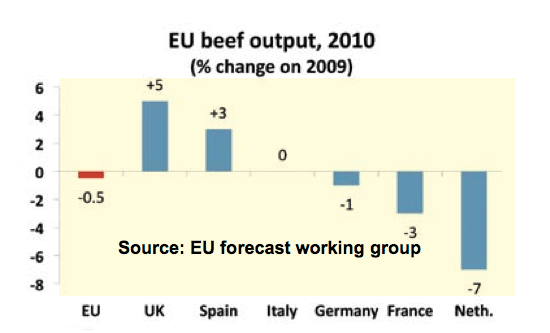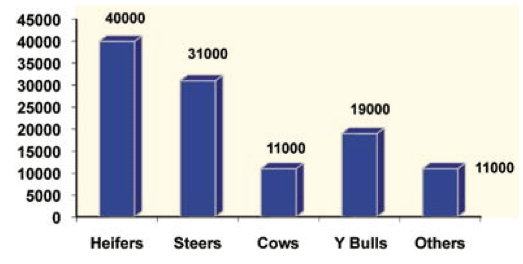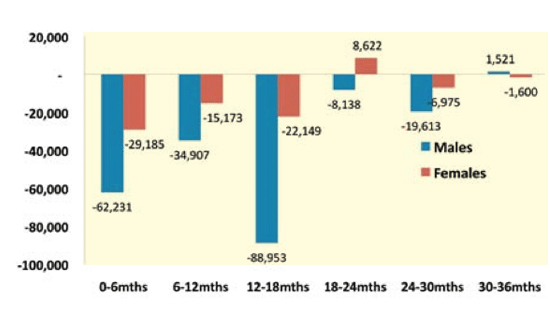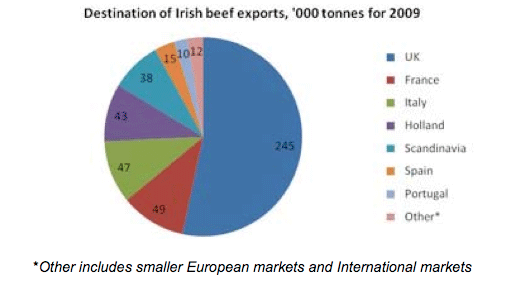



EU Beef Market Prospects
Following difficult trading conditions due to weak market demand, particularly for higher value cuts, the European beef market has shown signs of stabilising over recent months as a combination of tighter availability and a more positive currency situation has helped the trade, says Padraig Brennan from Bord Bia.The prospects over the coming months point to the relatively tight supply situation continuing across a number of key European markets while Irish finished cattle supplies are also set to tighten.
More stable European market
Recent months have seen some indications that consumer demand for beef across Europe is starting to level off and in some cases improve, with a better trade reported for steak cuts. Latest household purchase data from the UK shows that for the quarter ending the 3rd October, the volume of beef purchased by UK households rose by two per cent to 64,000 tonnes. Figures for France show some slight recovery in beef consumption as the year progressed, following a very slow start to 2010 sales. Consumer decisions will be closely related to economic developments and with most of our main European markets forecasting some recovery in the second half of 2010, there is reason to expect some improvement in beef consumption.
Lower EU cattle supplies
In terms of beef supplies, some decline in EU beef production is anticipated. Some key beef producers, including France and the Netherlands are expecting lower output in 2010, with most of this occurring during the second half of the year. However, this will be partly offset by increased production in Poland, the UK and Spain.

UK beef production in 2010 is forecast to rise by around 5 per cent. Firm market prices have led to more dairy calves being utilised for young bull beef production with supplies in the January to October period 34 per cent higher than a year earlier. In addition, stronger imports of finished cattle from Ireland, higher than anticipated cow supplies and rising carcase weights have combined to boost UK production.
Looking ahead to 2011, little change is anticipated in UK prime cattle supplies, although, the rise in production from the dairy herd looks set to be maintained.
EU Imports recovering slowly
In terms of EU beef imports, some recovery is expected for imports during 2010 with shipments forecast to increase by around five per cent to 440,000 tonnes. However, this would leave imports more than 15 per cent below the levels recorded as recently as 2007.
South American countries will remain the principal suppliers to the EU market, although, there is likely to be some shift in the volumes shipped by the main suppliers. Between Brazil and Argentina volumes of beef imported were down 15 per cent to 98,500 tonnes for the first half of 2010. Brazilian imports increased by just 2 per cent, while shipments from Argentina fell by 37 per cent over the period, reflecting the decline in beef output there. For the year, a fall of more than 40 per cent in Argentinean beef exports to 400,000 tonnes has been projected given the liquidation of the beef herd and Government restrictions on exports. Stronger imports, albeit from a small base, were also recorded from North America in the form of higher value cuts. Given the anticipated supply/demand developments for 2010, the European beef market appears to be heading into a more stable period, which should help the market environment for Irish beef.
Irish cattle supplies to tighten
To-date, finished cattle supplies at export meat plants have been strong as a combination of a higher carryover from 2009 and limited live exports of calves and weanlings in 2008 have boosted availability. Up to the week ending, the 16th October total export meat plant supplies were 112,000 head or nine per cent above the corresponding period a year earlier.
Increases have been evident across all animal categories with the growth in young bull disposals continuing with supplies almost 19 per cent higher up to mid October. The largest percentage growth has been evident in bulls and heifers.

Figures from the Department of Agriculture, Fisheries and Food’s AIM database for the 1st August 2010, confirm the decline in younger cattle numbers due to lower calf registration and higher live exports over recent years. The figures show a drop of 279,000 in the number of cattle less than 36 months, with 253,000 of this drop evident in animals less than 18 months of age.

Trends in cattle numbers by age, August 1st 2010
(Change in head on August 2009)
The figures for 18 - 36 month old animals showed a fall of 26,000 in male cattle while females were unchanged on 1st August last year.
However, strengthening male cattle disposals since the 1st August have been offset by lower supplies of female cattle. During this period, an increase of 13,000 in male cattle numbers was evident with 7,000 fewer females marketed. This would point to a tightening in steer and heifer supplies as the onset of the winter season approaches. However, this is likely to be partly offset by young bull supplies remaining ahead of last year. The main uncertainty regarding disposals over the coming months surrounds the likely producer reaction to higher feed costs. Any effort by producers to reduce their reliance on animal feed over the winter months could impact on marketing patterns over the coming weeks.
The strength of live exports since late 2008 combined with lower calf registrations seems set to lead to a significant tightening in finished cattle supplies in 2011 as demonstrated by the drop of almost 90,000 head in the number of male cattle aged between 12 and 18 months on the 1st August 2010 with female numbers in the category down by 22,000 head.
EU cattle prices
Cattle prices across Europe has been sluggish for much of 2010 as consumer spending on beef remains below traditional levels as consumers look for increased value. On a year-to-date basis the weighted EU-15 R3 male cattle price is running two per cent lower than last year at €3.13/kg. Recent months have seen some pick up with the EU-15 price in the first half of October one per cent higher at €3.14/kg compared to the corresponding period last year.
Male cattle prices among most leading producers have fallen by around one per cent on a year to date basis with Italian prices some five per cent lower and UK prices down by one per cent in euro terms. Prices for October showed mixed trends with prices in the UK, Spain, France, Germany and Sweden ahead of October 2009 levels. However, Italian prices are running around three per cent lower.
Irish R3 steer prices to date are virtually unchanged on last year’s levels at €2.90/kg while prices in the first half of October were five per cent higher at €2.85/kg.

Markets for Irish beef
For 2010, beef exports are anticipated to increase by over 5 per cent to almost 490,000 tonnes, reflecting increased beef availability during the first half of the year. The UK market will continue to account for half of Ireland’s beef exports, although the emphasis on other European markets continues to grow.

The UK remains in a deficit beef position, with the latest EU beef forecasting meeting indicating the UK will import 406,000 tonnes during 2010. The current market position of Irish beef in the UK leaves the industry well placed to fill any increased requirements, particularly as the weakening of the euro against sterling has helped improve the competitiveness of Irish beef in the market.
Continental European markets continue to grow their share of Irish exports with 47 per cent of exports destined for this region in 2009. Key markets include France, Italy, the Netherlands and Scandinavia, which between them account for more than 80 per cent of exports to the region. Overall volumes to the Continent in 2010 are expected to rise in 2010, reflecting stronger availability to-date. Further growth in the share of exports destined for the region is expected in 2011.
Across Europe Irish beef is stocked in three or more of the top 10 retailers in each major market and in over 70 retailers in total. By the end of 2009 some 200,000 tonnes were destined for the higher value standard and premium retail and premium foodservice markets, with a further 75,000 tonnes of quality assured beef destined for the high quality high volume quick service restaurant sector.
Young bull beef from the dairy herd
The ongoing rise in young bull supplies in Ireland reflects their relatively high feed efficiency compared to steers and the potential this offers producers to improve returns. However, it also represents a system of production that requires a strong focus on producing a finished animal that is suitable for the marketplace. Most customers have age, weight and fat cover requirements and if these are not met it can lead to significant price discounts.
In relation to markets for bulls from the dairy herd, the options open to producers range from rose veal for animals less than 12 months of age to young bull beef production. For bulls over 12 months of age, there is a potential market for young bull beef from the dairy herd. However, animals need to be finished within a relatively tight specification. Typically, this will range from animals being finished at 12-16 months of age, producing a carcase of 240-340kg and ideally grading O= or better on conformation. In terms of fat score the general requirements range from 2+ to 4-.
January 2011


